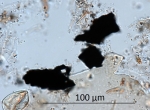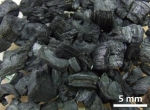Microscopic and macroscopic charcoal in sediments
Microscopic and macroscopic charcoal in sediments. The origin of fires (natural, or anthropogenic?), their regionalization, frequency and extent, are relevant issues in paleoecology. Fire was used in diverse technologies and farming systems during different periods of prehistory. Some particles of organic matter that survive in lake sediments and peat deposits are associated with fires and fire use. When it is present in a palynology sample microscopic charcoal (fig. 1.) is counted parallel to the pollen grains. Macroscopic charcoal (fig. 2.) is retrieved from sediments during the sorting of macroscopic plant and animal remains under a stereoscopic microscope. The results of analysis are listed in pollen and macrofossil diagrams. Individual size grades of microscopic (fig. 1. ) and macroscopic (fig. 2.) charcoal represent fires that occurred at a greater distance from the site or close to it, respectively. The lower classes of microscopic charcoal correspond to fires on a regional scale, macroscopic charcoal documents local fires. A high percentage of microscopic charcoal in pollen diagrams often goes hand in hand with a high percentage of pollen and spores of fire indicator plants of woodland habitats (e.g., Common bracken Pteridium aquilinum, Cow wheat Melampyrum, Rosebay willowherb, in North America known also as Fireweed Chamaenerion angustifolium) and may also be accompanied by spores of specific fungi (Neurospora and others).
ML, JŚM, AP, MZ
Literature: K. Tolonen, Charred particle analysis (in:) B.E. Berglund (ed.), Handbook of Holocene palaeoecology and palaeohydrology, Willey & Sons Ltd., Chichester-New York, 1986, pp. 485-496; W. Tinner, M. Condera, B. Ammann, H.W. Gäggler, S. Gedye, Jones R., B. Sägesser, Pollen and charcoal in lake sediments compared with historically documented forest fires in southern Switzerland since AD 1920, The Holocene 8, 1998, pp. 31-42; J.J. Blackford, Charcoal fragments in surface samples following a fire and the implications for interpretation of subfossil charcoal data, Palaeogeography, Palaeoclimatology, Palaeoecology 164, 2000, pp. 33-42; C. Whitlock, C. Larsen, Charcoal as a fire proxy (in:) J.P. Smol, H.J.B. Birks, W.M. Last (red.), Tracking Environmental Change Using Lake Sediments. Volume 3, Terrestrial, Algal, and Siliceous Indicators, Kluwer Academic Publishers, Dordrecht, 2001, pp. 75-97; Latałowa, Holocen, [in:] S. Dybova-Jachowicz, A. Sadowska (eds.), Palinologia, Wydawnictwa Instytutu Botaniki PAN, Kraków, 2003, pp. 273-307; M. Latałowa, Gospodarka człowieka w diagramach pyłkowych, [in:] M. Makohonienko, D. Makowiecki, Z. Kurnatowska (eds.), Studia interdyscyplinarne nad środowiskiem i kulturą w Polsce, Ser. Wyd. Stowarzyszenia Archeologii Środowiskowej, Środowisko – Człowiek – Cywilizacja, volume I, Poznań, 2007, pp. 171-187.
-
 full resolution
full resolution
Fig. 1. Microscopic charcoal in a pollen sample. Photo A. Pędziszewska.
-
 full resolution
full resolution
Fig. 2. Macroscopic charcoal. Photo K. Pińska.


